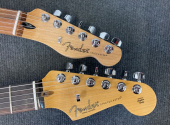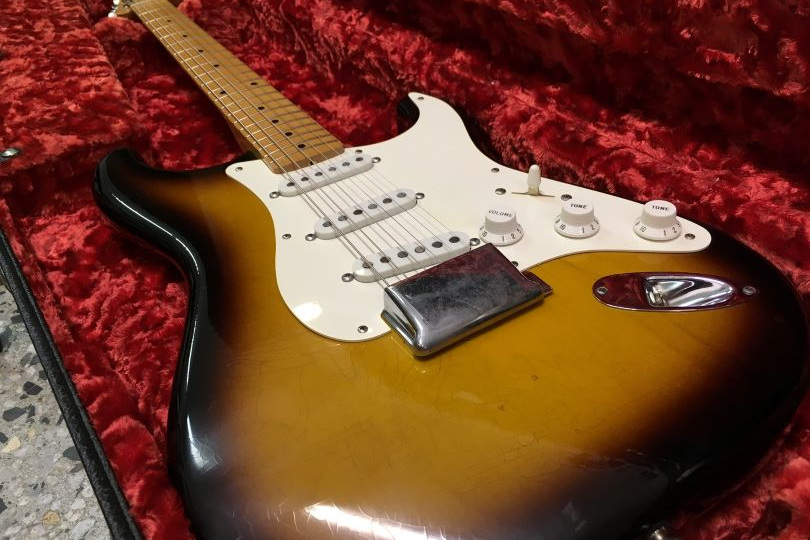
Under the Hood #12: The Timeless Value of the Stratocaster
The Stratocaster is one of the most sought-after guitars due to its shape and sound. Its design has hardly changed over several decades. Its journey to the limelight was by no means easy—it took several years for it to become more widely known. It was also not available in Europe for a long time. Let's have a closer look at the uniqueness of the Stratocaster, the reason why it was ahead of its time, as well as at its drawbacks.
When Leo Fender came up with the Telecaster in the early 1950s, followed by the Precision bass, it was a fairly radical shift in design, sound and playability. The Telecaster was a perfectly simple guitar that was great for its time, but its flaws emerged with its more frequent use. And because guitarists asked for its improvements, Fender came up with the Stratocaster.
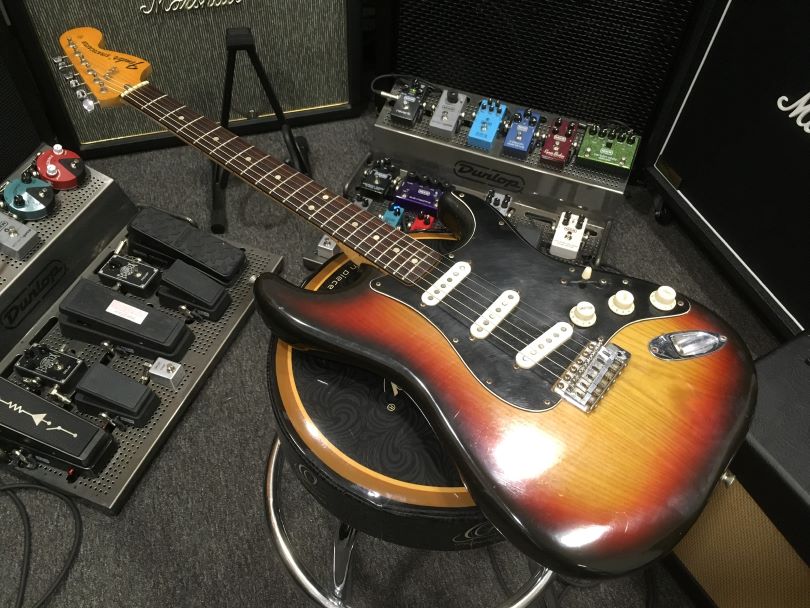
The birth of the Stratocaster
Leo Fender and his team started working on the design of a new guitar probably sometime in 1952. Fender company gathered feedback from guitarists who played Telecasters and tried to understand and accommodate their latest requirements. It’s important to remember that there were not many electric guitar models then. Players were just becoming familiar with the new sound and design. Playing comfort and adjustability of the whole guitar were important factors.
The Telecaster soon ran into its limits, such as limited octave tuning, a large angular body pressing the player’s ribs, or a few sonic options. Another requirement was a vibrato system.
Had it not been for the initial setback with the prototype bridge system, the Stratocaster would likely have been released a year earlier. It didn’t happen though, so it didn’t see the light of day until 1954. Therefore, this year became a significant milestone in the history of guitars and music.
In an excellent article directly on the Fender website, we can learn the exact price of these guitars. Stratocaster tremolo version was sold for 249.50 dollars. The hardtail model was cheaper—229.50 dollars. Compared to today, when the prices of early Stratocasters from the 1950s are astronomical, it’s small potatoes.
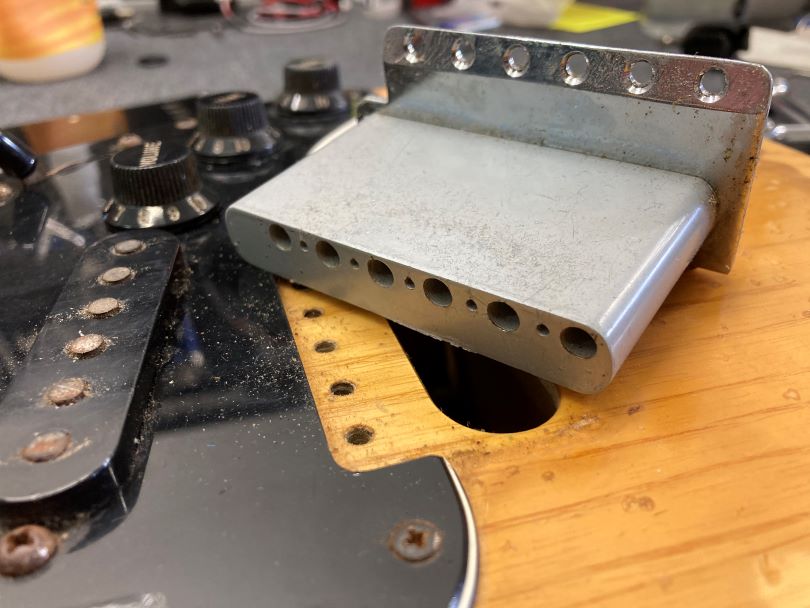
The bridge that changed the world of music
Stratocaster’s most significant innovation is the bridge. Leo Fender himself caused misunderstanding in the world of musicians when he called the system a tremolo. However, this name has caught on, so we will also use it in this article.
The Telecaster had a fixed bridge bolted from the top of the body. While it guaranteed tuning stability, it didn’t provide as many options as its successor. Thanks to the construction, this new “tremolo” bridge offered a wide range of possible rapid sound changes. Thanks to the tremolo arm, the guitarist could play a sound that was several notes higher or lower and immediately return to the original pitch.
The tuning instability was the disadvantage of the previously known tremolo models, such as the Bigsby. Changing strings was also not exactly easy. Leo Fender designed the first prototype of the bridge according to already established models, i.e. with rollers for individual strings. This, however, resulted in a poor sound. So Fender stopped production of the first tremolo and redesigned the whole thing.
The outcome was an ingenious system. The strings went all the way through the fretboard, improving the sustain, the bridge tilted together with strings. Only the front part was attached to the guitar and was also bevelled to tilt back and forth without resistance. The whole block went through the guitar body and was anchored at its back with springs that balanced the tension of the tuned string.
The design ensured tuning stability. Changing strings became very comfortable, as well. Another advantage was that each guitarist could adjust the tremolo to their own needs.
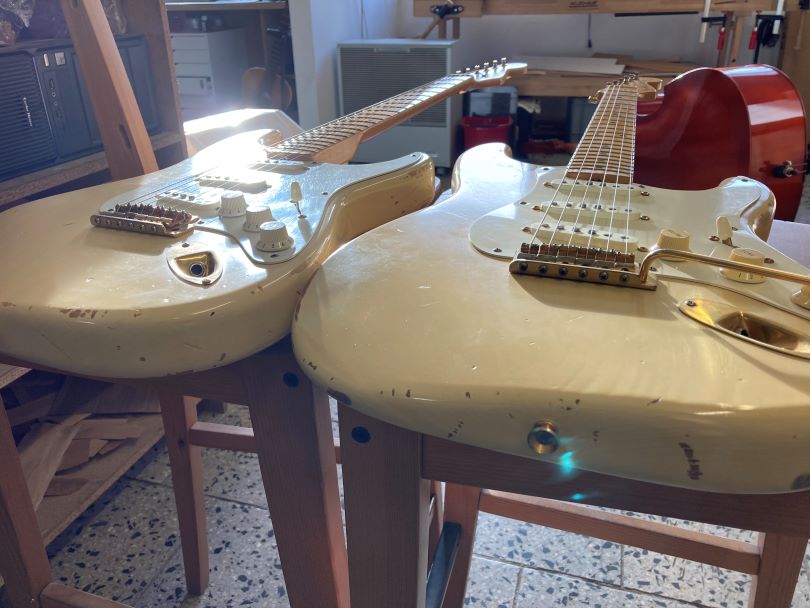
Rounded body edges increased playing comfort
As we’ve already noted, one of Telecaster’s drawbacks was its angular body. In the above article published on Fender’s website, there is a paragraph explicitly devoted to the body edges rounding. Rex Gallion believed that the guitar did not need sharp edges. So on his advice, the Stratocaster got rounded body edges on the front and back side. Everything adapted perfectly to the player’s forearm, and the playing became much more comfortable.
The rounded edges also helped the design of the whole guitar—it made it look much more appealing. Compared to the Telecaster, which is described as a board, the Stratocaster looks modern, sleek and stylish. However, it must be said that, at first, musicians still preferred other instruments, and it took them a few years to get used to the new design. Like any innovation of this scale, Fender guitars took a little time to become widely accepted.
It’s incredible that a man like Leo Fender could come up with so many innovative designs in such a short time. He was always surrounded by the right people who put their hearts into the guitar development. The advantage was that many Fender employees took new guitars right from the factory to play them at their gigs and then shared all the pros and cons. This allowed Fender to get closer to the actual players’ requirements.
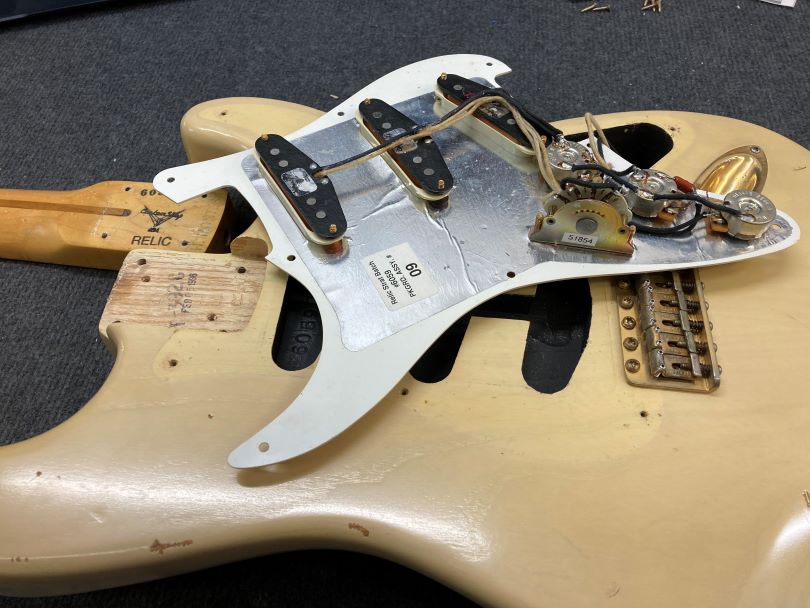
Pickguard mounted electronics simplified everything
In the first electric guitars, the electronic controls and pickups were usually placed in the guitar body. This was also the case with the Telecaster, where the controls had their own separate cavity. With the Stratocaster, it all changed.
Except for the female jack, electronics were completely mounted to the pickguard. This meant that they were independent of the guitar body and could be removed and repaired at any time. It simplified everything. Factory production could concentrate purely on the electronics, and the finished pickguard was then soldered to the guitar with a wire connecting the female jack. The pickguard was plastic, in some cases aluminium.
Three pickups instead of the usual two made a significant difference in sound. It allowed guitarists to create more sound combinations. There was a three-position switch between the pickups to select each of them. Later, in 1977, Fender began using five-position pickup switches on Stratocasters that allowed two pickups to be plugged in at once. This option is now standard, as the sound of the intermediate position—with two single-coil pickups playing simultaneously—is very popular. However, guitarists had figured out that it was possible to activate two pickups at a time by gently jamming the switch into the intermediate position. This setup was rather fragile though, as the lever would return to one of its original positions when shaken harder.
The pickups had the magnet poles set according to the strength and radius of the strings, so the sound was much more balanced. Over time, Fender started using alnico 5 magnets. Of course, the pickup height could also be adjusted, so everyone could customize the sound.
The pots were now placed closer to the guitarist’s hand, just below the strings. Volume was controlled easily and quickly without the guitarist having to move their hand significantly. The bottom two pots were tones for the neck and centre pickups. The bridge pickup was controlled only by the volume pot—the tone was not usually connected to it.
However, adjustments to the electronics were straightforward, thanks to their simplicity and easy availability so that anyone could make the wiring their own.
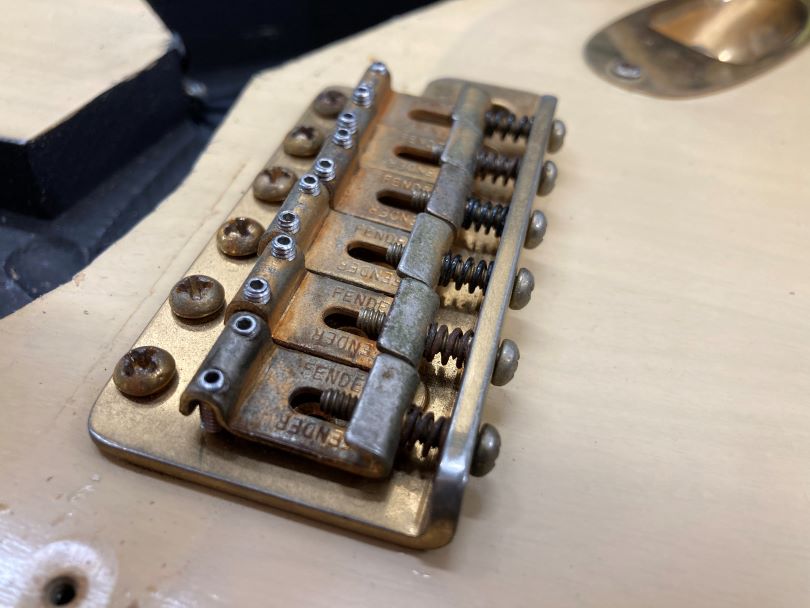
The guitar setup was complex and innovative
The undeniable advantage of the Stratocaster is its adjustability. Since, like other Fender guitars, it consists of dozens of removable parts, everything can be precisely adjusted and repaired.
Also innovative were the six separate adjustable saddles on the tremolo bridge. This solved a problem known from the Telecaster, on which it was difficult to tune octaves and to adjust overall intonation because there was one saddle for two strings. Now each string was tuned separately so that tuning could be truly accurate. At the same time, the saddles could be conveniently adjusted in pitch as needed, especially according to the fretboard radius.
Adjusting the tremolo with springs made it possible to use the tremolo arm sensitively. The tremolo could have been set as non-floating, when its entire surface lay on the guitar body and when the tremolo arm was used, the strings were undertuned. When it was set as floating, the tremolo was entirely in the air, only anchored to the body by six screws on the front part. This allowed for both undertuning and overtuning when using the tremolo arm. By anchoring the strings directly in the tremolo block, greater tuning stability was guaranteed.
Thanks to the bolted neck, its angle to the body could be adjusted if needed. The adjustable neck truss rod was already standard and allowed sensitive adjustment of the neck bow.
Adding to that the adjustment of the pickup height, we get a guitar that can be tailored to the player’s specific needs down to the smallest detail. This is the magic of the Stratocaster, which I appreciate especially as a guitar technician.
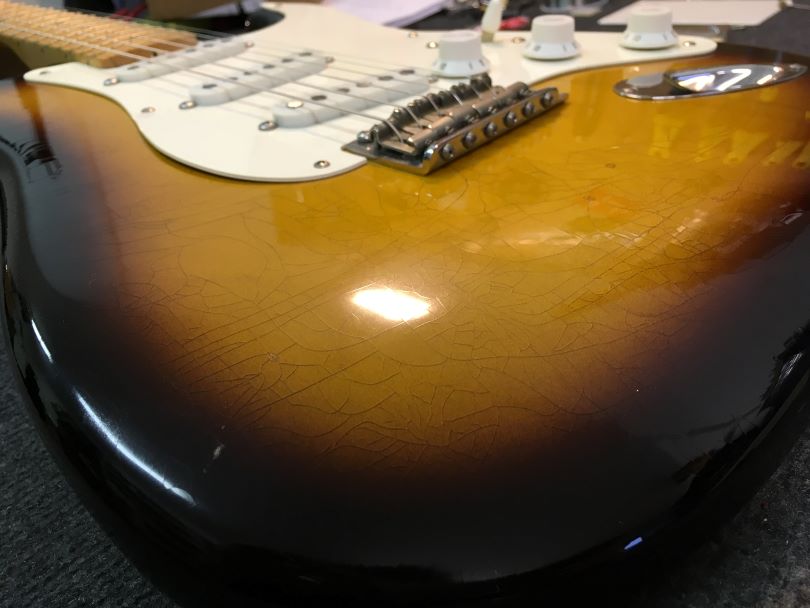
Stratocaster’s colours
Stratocasters’ typical lacquer colour has been a 2-colour sunburst from the beginning. The edges of the body were painted dark brown, the rest of the body yellow. This made it possible to both hide the inconsistency of the annual rings of ash wood, and it made a nice effect.
In the late 1950s, red was added to the sunburst. From about 1957 onwards, it was possible to order a different, custom colour from Fender. These were still being developed and had to make their way through the initial reluctance of the Fender management, as George Fullerton documents in an extensive interview. He himself describes the ridicule he received from the people at Fender when he first presented a red lacquered Stratocaster to them. However, he persisted in his intention, and custom colours became widespread after that.
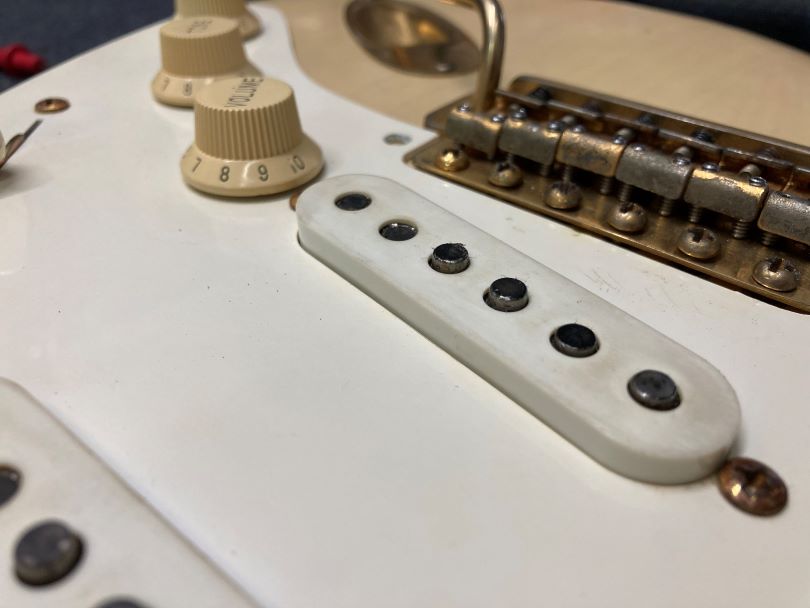
The disadvantage is the placement of the truss rod at the end of the neck
From a guitar tech’s point of view, I must point out one disadvantage that Stratocasters have. It is the adjustable end of the truss rod located at the end of the neck.
If the neck bow needs to be adjusted, which is very common, it is necessary to loosen the strings, unscrew the neck, move the truss rod and then screw the neck back on and tune the strings. If the adjustment of the bow is still not sufficient, the whole process must be repeated. Guitarists do not mind it; however, it is tedious and requires experience.
To close
In my opinion, the Stratocaster is a timeless guitar whose design and sound advantages will never get old. I would have loved to relive the heyday of these guitars, especially when, for example, in the late 1950s Hank Marvin played the Stratocaster as probably the first guitarist in the UK to conquer the music world there.
If you have found an error or typo in the article, please let us know by e-mail info@insounder.org.


